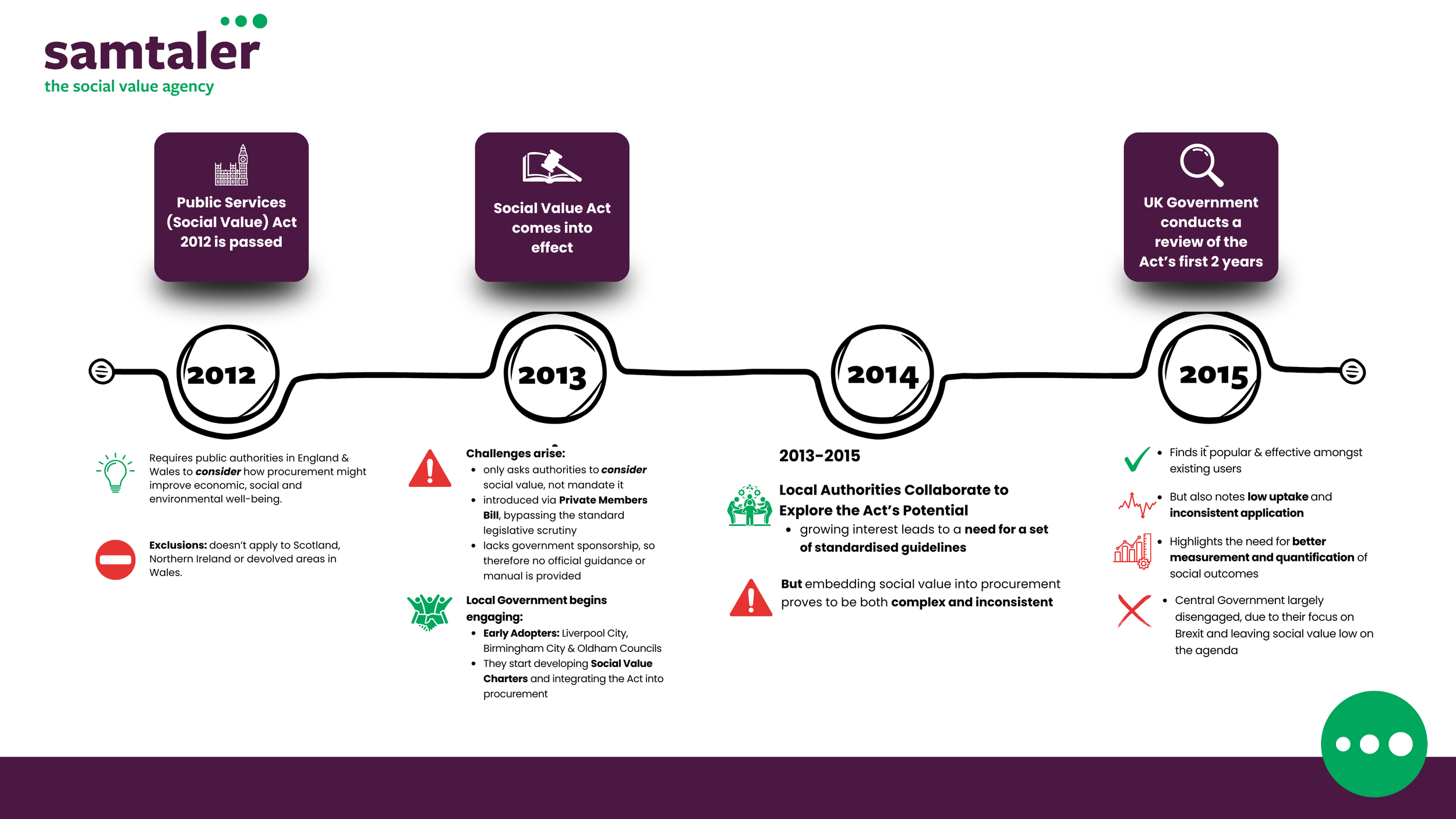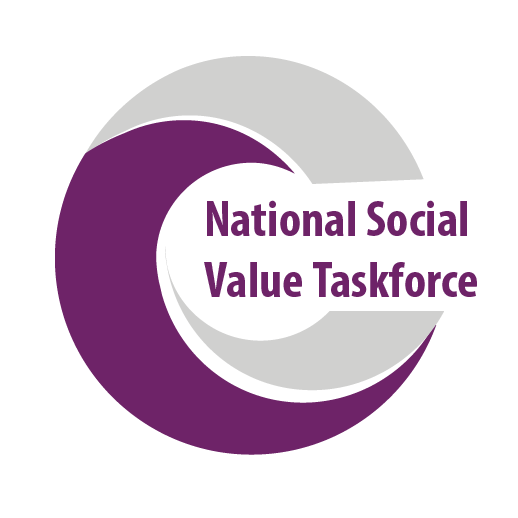The Social Value Model versus the National TOMs; What's the difference?
Updated Oct 2025
For the latest guidance on the Social Value Model take a look at the Social Value Model blog.
Social value may now be an accepted feature of almost all major UK public sector purchasing decisions, but with over 1,200 different government agencies and public sector bodies, there are significant variations in how it is being applied to procurement processes. That can lead to a lot of confusion for suppliers who are seeking to structure their internal processes and systems to respond to social value questions effectively across a range of markets.
Differences between Devolved Nations
Social Value is integrated into public sector procurement processes very differently across England, Scotland, Wales & Northern Ireland.
This article focuses on how social value is applied in England.
Photo By: Brendan Church on Unsplash
What are the Social Value Model and the National TOMs?
They are both frameworks which help public sector procurers incorporate social value requirements into their procurement processes. Both contain:
‘lists’ of social value related outcomes that procurers can use to integrate social value requirements into tender documents.
evaluation metrics and award criteria, which allow procurers to differentiate between suppliers’ answers.
Where they differ is in how they do these things.
Why are they different, and who is using them?
The National TOMs (TOMs) was introduced in 2016 by the Local Government Association's Social Value Taskforce to help Local Authorities at a time when no other advice or frameworks existed. Not all Local Authorities are using the TOMs. There are no accurate figures available but our best guess is that around one-third of councils in England and Wales are using them. This means lots of Local Authorities are using their own systems and frameworks so you’re bidding for local government contracts, you should still expect to see lots of variation.
The Social Value Model was introduced in June 2020 by the Cabinet Office to help central Government embed social value into their procurement processes. It was updated in February 2025 and a New Social Value Model took effect on 1 October 2025. It is UK Government Procurement Policy and must be used by all Central Government Departments, their Executive Agencies and Non-Departmental Public Bodies. That's over 400 different organisations; you can find a list here.
“As a rule of thumb, if your customers are Local Authorities in England, you are more likely to see the TOMs or a version of it . If they are Central Government Departments or other UK Public Sector Bodies they will use the Social Value Model.”
What are the key features of both frameworks?
The Story behind Why Local and Central Government Approach Social Value Differently
-
To understand why we have two different systems, we have to go back to 2013, when the Public Services (Social Value) Act 2012 (the legislation which brought social value to public sector procurement) was first introduced.
The Social Value Act requires public authorities to consider how what is proposed to be procured might improve the relevant area’s economic, social and environmental well-being and how, in conducting the procurement process, it might secure that improvement.
The legislation only applies to public authorities in England Wales. It does not apply to public authorities in Scotland, Northern Ireland and those responsible for Devolved areas in WalesThe Act wasn’t widely embraced in the early years for several reasons:
It only requested public authorities ‘consider’ social value – it didn’t mandate it.
It was introduced onto the statute books via a process known as a Private Members Bill, which meant it circumvented the ‘usual’ standard legislative process.
Perhaps most importantly, because a Government department hadn’t sponsored it, it didn’t come with the guidance and advice which usually accompanies legislation. In other words, there was no manual for applying or using it.
Initially only Local Government realised its potential. Early adopters included Liverpool City, Birmingham City and Oldham Councils, who in 2013 began developing Social Value Charters and considering how to incorporate this legislation into their processes.
For several years, Local Authorities worked together to try and use this new legislation to generate benefits for their regions, but embedding social value requirements into procurement processes is a fiddly business. As more and more Local Authorities wanted to take up the mantle, the need for a standard set of guidelines became pressing.In 2015 a UK Government review of the Social Value Act’s first two years found; it had proved popular and effective amongst those who had used it; but the number of people using it was low; and understanding of how to apply the Act varied, with inconsistent practice in commissioning social value and bidding for social value contracts.
Another issue the review identified was the need for commissioners to measure better and quantify the social outcomes they were seeking to embed in a procurement process. At the time the UK Government was distracted by Brexit, and social value wasn’t high on anyone’s agenda so Central Government Departments continued to largely ignore it.
Local Government Embraces Social Value
In the meantime the Local Government Association (LGA), the national membership body for Local Government, took up the mantle.
In 2016 it set up the National Social Value Taskforce to establish a good practice framework to integrate the Social Value Act into the UK public sector and business community.
Image Source: https://www.nationalsocialvaluetaskforce.org/
The Taskforce was a voluntary group comprised of private, public and third sector organisations who came together to help ensure effective implementation of the Act, in the absence of any other guidance from Government.
The first National TOMs were published in 2017, and they’ve been updated annually ever since.
Image Source: https://www.nationalsocialvaluetaskforce.org/
Fast forward to September 2020; Brexit, the Covid pandemic, and a series of scandals relating to public sector suppliers, (including the collapse of Carillion) had focused minds in Central Government on the importance of social value. Ministers decided they wanted social value to be explicitly evaluated rather than just ‘considered’ (as the Social Value Act required) but introducing new legislation to update the Act wasn’t practical. So the Cabinet Office pulled together a team of experts, created comprehensive new guidance (PPN06/20: taking account of social value in the award of central government contracts) and used a mechanism called a Procurement Policy Note (PPN) to introduce it.
And here’s the key: PPN06/20 only applied to Central Government Departments, their Executive Agencies and Non-Departmental Public Bodies. Local Authorities aren’t ‘in-scope’, which is why they aren’t using it.
In February 2025, the UK Government issued a new, updated version of the Social Value Model: PPN002. Published alongside a new, revised National Procurement Policy Statement (NPPS) which sets out the UK Government’s strategic priorities for public procurement, it came into effect alongside the Procurement Act 2023 on 24 February 2025.
All contracting authorities (e.g. government departments, agencies and local authorities) must “have regard” to the NPPS but only UK Government Departments and Arms Length Bodies must use PPN002. So the difference between Local and Central Government still remains.
OK, now you know why there are two systems, how can you prepare your procurement teams to deal with both?
Think about what your social value offer is
Whatever framework your procurer is using, social value outcomes need to be proportional and relevant to the goods and services being procured. So that means you should think about what you sell and the value that will be created for society through your delivery of the contract. Each framework has similar themes; jobs, supply chain, climate change for example. So think about what your business does in each of these areas. This mapping of your offer activity is something we do for clients regularly, so get in touch if you would like some help with it.
Look at who your public sector customers are and the kind of work you want to bid for
If you are an SME whose main focus is a handful of Local Authorities, ignore the Social Value Model and focus on the TOMs (or whatever system your local procurers are using). If you only sell to Central Government, ignore the TOMs and focus on the Social Value Model. If you are a large organisation whose customers are both local and central government, you need to prepare for both.
Acknowledge that there is no getting around the differences
If you are selling to both Local and Central Government, the only thing you can do is to familiarise yourself and your teams with both models. Social Value Portal have several free resources and webinars to help people understand how the TOMs work, and the Cabinet Office has produced a comprehensive guide on the Social Value Model. Some external training courses are available (you can find information about Samtaler’s here).
How to align your offer to the Social Value Model
We’ve created handy one-page summary of the themes, outcomes and model award criteria contained within each version of the Social Value Model, which you can use to map your activity. Go through each MAC and ask yourself, ‘what can we do through the delivery of the contract to….’
How to align your offer to the TOMs
Because the TOMs framework measures social value both quantitatively and qualitatively, the measures represent specific, tangible actions that organisations can take to deliver outcomes. With so many options available, you’ll usually find something that aligns with what you can provide.
But if you’re unsure how to shape your offer, or struggling to map your activities against the right TOMs, that’s where we come in. Our team can help you build a clear, credible offer that not only aligns with TOMs (or any other framework you’re working with) but also reflects the real impact your organisation delivers.
And if you find that certain measures don’t feel relevant or proportional, it’s important to feed this back – both to the Social Value Portal and to the procurer once the process is complete. Your input helps to keep the framework meaningful and practical for everyone.
Remember to be specific and have a good method statement
Whether they are using the Social Value Model or the TOMs, all procurers are looking for suppliers to provide specific, quantifiable social value commitments. Proposals need to be proportionate, and relevant, to the contract you are delivering, and should be backed by a strong method statement detailing how the commitment will be delivered.
In a nutshell…
The Social Value Model and the National TOMs are both frameworks that help procurers embed social value requirements in their tenders. They are used by a range of different public sector organisations in different ways.
As a supplier, the important thing to remember is that social value should be specific to the delivery of the contract and the needs of the communities you create positive outcomes for. Our top tip is to map out your answers to the themes and outcomes in both models and build a social value response library aligned to your business so that you are in a strong position to respond should a question come in from either.
At Samtaler, we work with our clients to help them understand what their social value offer is and then help them to pull that together into an answer that will both meet the criteria and be tailored to their delivery of the contract to give them the marks they need.
Who are the Social Value Portal?
Social Value Portal is a privately owned company that partnered with the Local Government Association in the early days to help develop the TOMs. They provide the secretariat function for the National Social Value Taskforce group and maintain and update the TOMs annually.
As well as administering the TOMs they also operate a digital tool (the Portal) which allows suppliers and procurers to capture and collect information about their social value activities. The Social Value Portal uses the TOMs to measure and assess the impact of their activities.
Social Value Portal also offer other services to public sector procurers. This includes collating the submission of bidders’ social value responses (via the Portal), evaluation of social value responses, and (post contract award) reporting and management of contracted social value commitments (via the Portal).
How we can help
At Samtaler, we understand the importance of your social value commitment. You’re here because you care about the impact your business has on society and want to be better. We want you to succeed, and we know from experience that achieving social value requires skill, strategy, and support.
To find out how we can help send an email to hello@samtaler.co.uk
Sign up to The Social Value Files for inspiration and practical ideas to create social value for your business.
If you liked this post please share.






WATCH NOW: Smarter Social Value – The Human Future of AI, Local Needs and Impact.